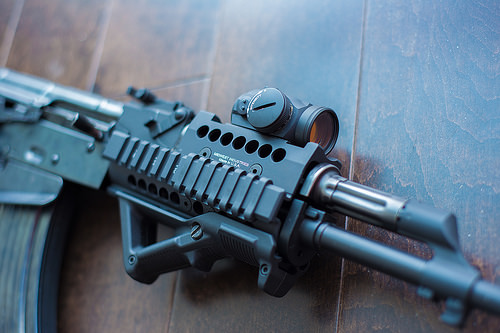However, when you look at the H1 and T1, you may ask yourself, what’s the difference, and which is better for me? Which is in the winner in the contest of Aimpoint T1 vs H1?
What They Have in Common
Both the T1 and H1 are red dot optics that use simple nonholographic red dots as their reticles. They are also both quite small and light and considered by Aimpoint as compact. Both feature unlimited eye relief and run off a single CR2032 battery. Both are capable of running up to 50,000 hours on daylight settings. They are both superb optics, made by one of the highest quality optics makers out there. They even look remarkably similar, but in reality they are quite different.
Where They are Different
You might as well refer to the H1 as the Hunter and the T1 as the Tactical since both were designed with a specific purpose in mind. On the outside, the optics seem to be interchangeable, but their mission set is as different as you can get. This is a very important consideration when thinking of Aimpoint T1 vs H1 questions.
The Tactical
The T1 was designed to fulfill the demand for a lightweight tactical optic for weapons with limited rail space that are often used in close quarters combat like submachine guns and short shotguns. The T1’s main strength is how small it is for CQB (close quarters battle); the lightweight prevents the optic from bogging the weapon down and its small size keeps it from adding bulk to the weapon.
The Hunter
The H1 or Hunter model was specifically designed to be used on a variety of weapons, including big bore revolvers, shotguns, hunting rifles, and even compound bows! The H1 is very versatile and offers hunter a dependable but lightweight optic that excels on hunting weapons. The H1 is the only optic that comes to mind when one wants something to interchange between their firearm and their bow.
“Piggybacking” On Larger Optics
The T1 and H1 are both small and light, and weigh only a mere 3.7 ounces with its mount, and weight is an important consideration for both the hunter and the tactical operator. The optics are the same size dimensions wise as well. While both optics are capable of piggy backing on larger optics this is a feature that is more prevalent on the T1 than the H1. Designated marksman using a magnified optic may have a real need for a close-quarters optic, and the T1 is perfect as a backup for close quarters work.
The Reticles
Both optics utilize a 4 or a 2 MOA red dot as it’s reticle. The H1 features 12 daylight settings and offers the most versatility from dawn to dusk shooting. The 12 setting also provide an overall brighter red dot for those with vision issues. The T1, however, offers 8 daylight settings and 4-night vision settings. Again tactical operators have no choice in when they could be called up, so night vision compatibility is a real concern.
The Mount Difference
The T1 (see full specs) also has the option of coming with the ultra-tough and extremely reliable Larue mount. Larue mounts are well known in the tactical community for their near bulletproof reliability. The H1 comes with the completely suitable and excellent Aimpoint mount. The difference between the two optics is the trigger puller’s intentions. If the T1 fails because of its mount someone could die, if the H1 fails you miss your shot at a trophy buck, which sucks, but you aren’t at risk of dying (unless you’re lion-hunting and you have one pissed off lion charging at you).
Budget Considerations
The H1 (see full specs) is also typically cheaper than the T1 (check current prices, though), which reflects the lack of the Larue mounting system. Those saved dollars can be used to buy ammo, pay for a tag and hunting license, or buy arrows to replace the ones you lost shooting without an Aimpoint optic. If you’re like most folks (and not, say, Donald Trump), then you need to always keep an eye on your wallet when you consider Aimpoint H1 vs T1 optics.
Rail Concerns
According to Aimpoint, the T1 is designed to be mounted on a section of 1-inch Picatinny style base and the H1 uses a Weaver style base. This makes sense when you look at the differences between the bases themselves. Picatinny is an international standard for tactical weaponry and is what nearly every modern country uses for its weapon. This includes the AR 15, the MP5, and even sniper rifles. The Weaver base has been more commonly associated with hunting than tactical use, especially on compound and crossbows with rail mounts.
Picatinny and Weaver rails are extremely similar, with only a small difference is the size of the cross slots. The Picatinny rail has a slot width of .206 and the Weaver has a slot space of .180. Typically most accessories and optics are interchangeable, but to get the most precision out of an optic it should be mounted to the right base.
Overall — Aimpoint T1 vs H1
While both optics are known for being incredibly tough and infused with the same durability, the U.S. Army trusts uses the T1, which does have one minor advantage. The T1 can be fully submerged up to 25 meters, aka 80 feet. The H1 is capable of being fully submerged, but to only 5 meters or 15 feet. This again reflects the intended uses if each optic, the T1 may find itself on the carbine of elite SEAL who needs to insert via water, and the H1 needs to be resistant enough to retrieve after being dropped in that unfortunate puddle.
Both the Aimpoint H1 and T1 offer their respective users a brilliant, high-quality optic. Like any Aimpoint optic out there these provide a near perfect option. The T1 (read reviews here) does offer a few exclusive features, including NVG capability, deep submersible capability, and a Larue mount. All of this does come at a higher price, but for the operator it may be seen as money well spent.
The H1 (read reviews here) offers a bright daytime reticle important to hunters because most shots will be done in the early morning or late evening. The H1, compared to the T1, lacks a few features. The H1 is capable of being used on the most versatile series of weapons, including compound bows and handguns.
If there is a clear winner in Aimpoint T1 vs H1, it’s down to what your intention is with a red dot. If you hunt four-legged animals, the H1 is your best bet. If you want to prevent a two-legged animal from stealing your TV, shooting you with an AK47, or bashing your head in with a lead pipe, then the T1 is it. The hunter is clearly matched with the H1 and the tactical operator the T1.






